
‘Armenia!’ Review: Exploring the First Christian Nation: The Wall Street Journal
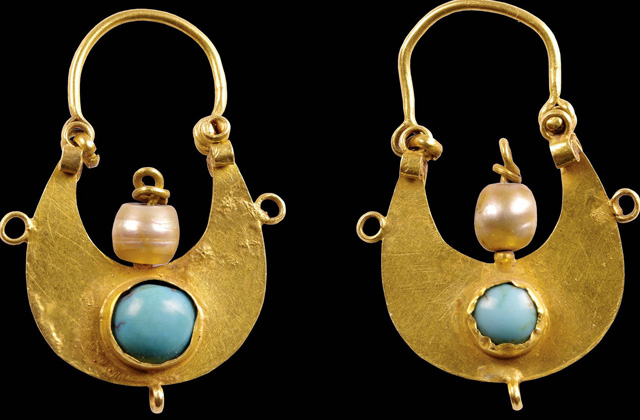
The Wall Street Journal: An exhibition at the Met is filled with objects that make it clear that, for their creators, the celebration of beauty was also a religious act.
It is remarkablehow deeply rooted our greatest art museums are in the religious realm. Artifacts reflecting profound faith – even those once used in the most sacred rituals – are at the foundation of these institutions. Removed from their origins in worship, these relics, illuminations, reliquaries and statues settle into an afterlife in our secular aesthetic temples, making it clear that for their creators (as for many viewers) the celebration of beauty is also a religious act.
Such are the impressions left, too, by “Armenia!” at the Metropolitan Museum of Art. The title’s exclamation point promises a sensation of amazement the Met has long cultivated. Gathered in eight galleries are more than 140 opulent Armenian artifacts created over more than a millennium beginning in the fourth or fifth centuries, many of which have not traveled for centuries and most of which have never been seen in the U.S.
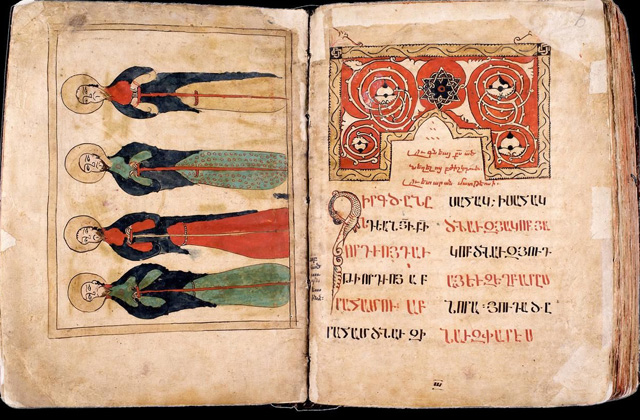
Gospel book, Berkri, Lake Van region (Vaspurakan) (1338),. illuminated by Melk’isedek PHOTO: HRAIR HAWK KHATCHERIAN AND LILIT KHACHATRYAN
Yet, secular amazement aside, with very few exceptions these are artifacts of devotion and worship, created by one of the world’s most ancient cultures and organized by Helen C. Evans, the curator of Byzantine art at the Met and C. Griffith Mann, a curator of Medieval art at the museum. Here is a 13th-century liturgical book stand that once held the Lectionary of the Armenian Church, the vegetal and animal carvings testifying to fertile spiritual ground; and here, too, is a 3,000-pound stone Khachkar—a monumental carved image of the cross typically set into the walls of churches and monasteries, this one made in the late 12th-early 13th century, in which the cross is surrounded by delicate filigree of carved rock. There are gold-leaf illuminations of Gospel books and Bibles; ornate reliquaries said to hold relics of martyred saints; 17th-century ceremonial garments of gold, silver and silk threads.
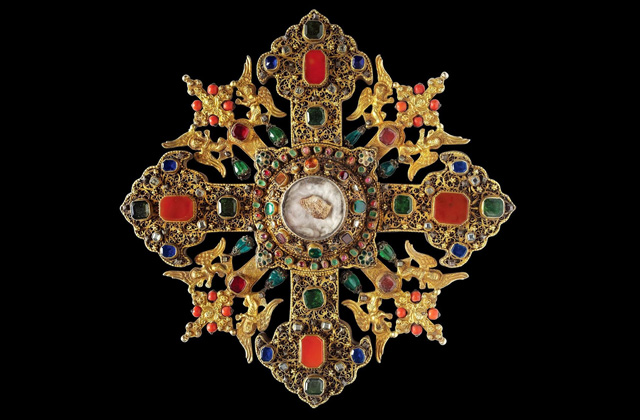
Reliquary cross with relics of St. George, Lake Van region (Vaspurakan) (1746) PHOTO: HRAIR HAWK KHATCHERIAN AND LILIT KHACHATRYAN
These are the traces of a distinctive faith, for though Armenia’s history is ornate and knotty and scarred by exile, disruptions and 20th-century mass killings, and though its lands were battered by Islamic conquest (Armenian terrain touching on regions between Turkey and Iran), we sense an astonishing consistency, a set of traditions and beliefs maintained over centuries.
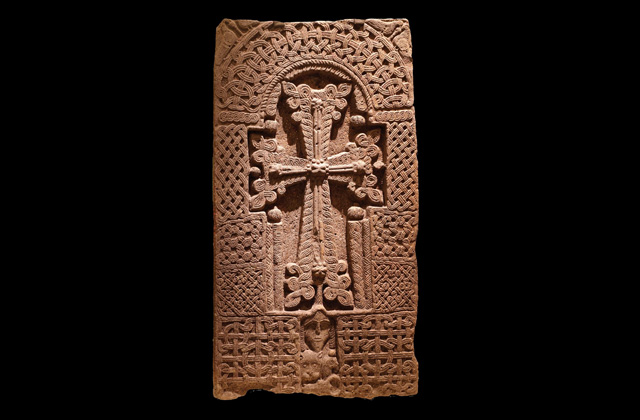
Khachkar, Lori Berd, (late 12th-early 13th century) PHOTO: HRAIR HAWK KHATCHERIAN AND LILIT KHACHATRYAN
Armenia is considered to have been the first Christian nation, its commitment sealed by a primal conversion, commemorated by the first artifact here: a four-sided stela from the fourth-fifth century showing an animal-headed man who may be King Tiridates the Great, who, out of stymied passion for a nun, brutally massacred her community, but was then converted to Christianity by the haloed St. Gregory, here carved in stone. An 13th-century English map of the Holy Land, drawn by a monk who spoke with Armenian travelers, shows another myth of origin: Armenia as the home of Noah’s ark, the boat resting on the peaks of Mount Ararat.
We learn, too, that over the centuries, Armenians became global traders, situated at a crossroads and having, at times, access to three bodies of water: the Mediterranean, Black and Caspian seas. We see jewelry of the 11th-13th century from the Armenian city Dvin, which was, until its Mongol destruction in the 14th century, one of the largest cities east of Constantinople.

Radiate Cross, Ani (11th-12th century) PHOTO: HRAIR HAWK KHATCHERIAN AND LILIT KHACHATRYAN
But it is not the artifacts of trade that are the attractions here, but the artifacts of faith. The Armenian kingdom of Cilicia on the Mediterranean may have had connections with the Crusader states, and Armenian merchants were active on trading routes that led them to England, China, India and Russia, but we are primarily aware of Armenian Christianity: It seems both precarious yet invariably firm—as if resembling the Ark resting on Ararat.

Gospel Book with enameled and jeweled silver plaques, manuscript: probably Cilicia, 13th century; plaques: Kayseri, 1691. Silversmith: Astuatsatur Shahamir PHOTO: THE METROPOLITAN MUSEUM OF ART, NEW YORK
We accept that impression without fully grasping it in detail: The show’s main flaw is that we never get a very clear picture of the distinctive aspects of Armenian Christianity. Yet we are suffused with its spirit as we make our way through the galleries. Some sense of its distinctiveness also arises from the photographs of churches and monasteries, both at the show and in the sumptuous catalog, looking as if hewed from rugged landscapes of mountain, rock and sea.
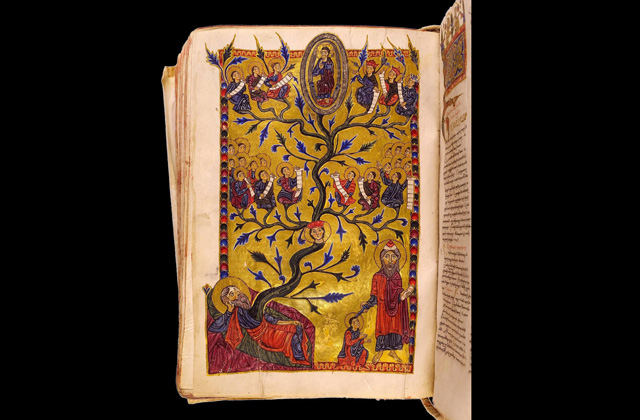
Bible, Monastery of Gladzor, Siwnik‘, (1318), illuminated by T‘oros of Taron PHOTO: HRAIR HAWK KHATCHERIAN AND LILIT KHACHATRYAN
Here, we see, is a cosmopolitan culture under persistent assault and subject to perennial accommodation that yet held fast to its religious foundation in cloistered, forbidding settings. A devotional spirit is cast by the sounds from one gallery where we hear “Miajn Surb” from “Les Chants de La Liturgie Armenienne” by Makar Yekmalian (1856-1905), a work that seems to mix aspects of Gregorian chant with folkish turns and a sensuous serenity.
By Edward Rothstein
Read more here.























